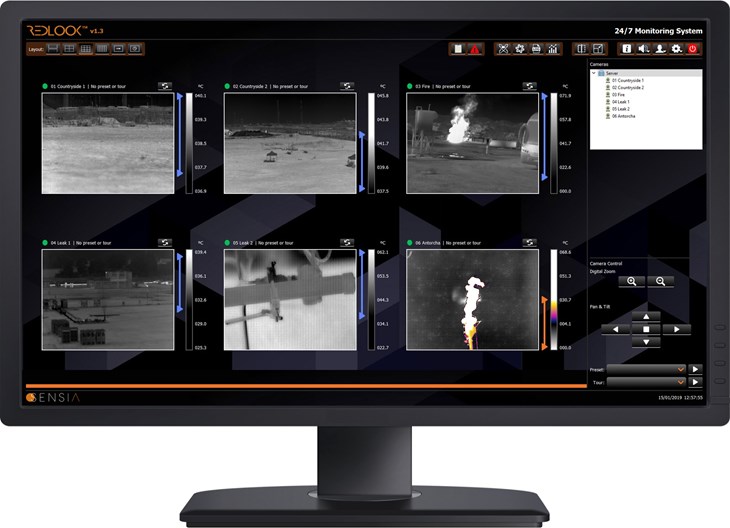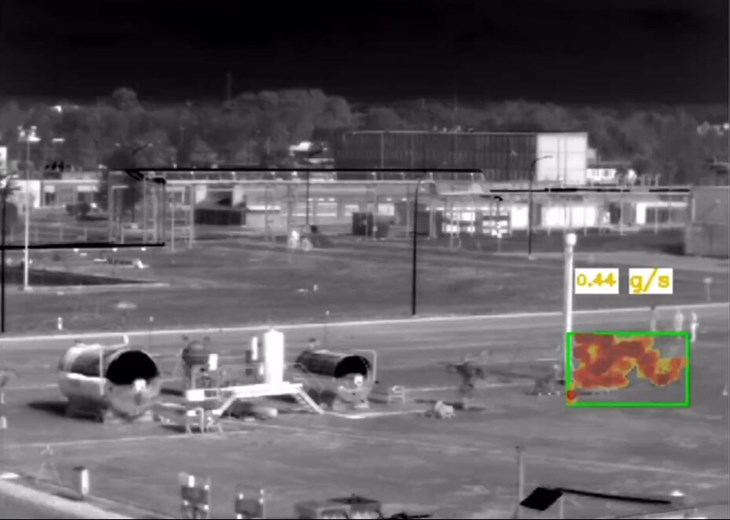Point sensor networks are the traditional method used to monitor these types of premises, but new cost-effective solutions using infrared (IR) imaging may offer a wider range of coverage to manage the challenges of Health, Safety and Environment (HSE) departments.
Infrared Imaging Technology: Background
All objects above absolute-zero emit electromagnetic (EM) radiation. The intensity of this radiation is temperature dependent according to blackbody laws, which explains why it is also known as thermal radiation. This energy radiates mainly in the infrared window of the EM spectrum.
Similar to how a Charged Coupled Device (CCD) or CMOS array works for visible light, Infrared (IR) detectors
are sensitive to IR wavelengths. One of the key features of infrared technology is the capacity to image using Focal Plan Array (FPA) sensors. IR imaging technology is an advanced tool, capable of bringing structure and clarity to complex and abstract contexts. The cross-cutting nature of infrared science makes it the ideal technology for a range of industrial problems regarding the environment, health, energy efficiency, safety, and
agriculture, among others.
IR imaging technology has progressed significantly over the last two decades; big achievements have been made in microsystem technology, thanks to the development at the component level of high performance and low cost new sensors, electronics, optics, and computing. In addition, competitiveness within a robust and growing industry has led to a low-cost, IR device manufacturing race, as the technology opens a vast market of new users. These conclusions are found in various market studies (i.e. MarketsAndMarkets, Yolé Development) that foresee mid & long wave IR sensing applications will reach high volume markets in coming years.
The reason that hindered the large scale penetration of IR imaging (high cost) in industrial applications has been overcome. Nowadays, IR imaging is paired with cost-efficiency.

Infrared Imaging in the Digital Industry
In addition to cost-effectiveness, the industry demands the highest level of performance with a minimum or even zero-level of manual supervision needed.
Typically, IR imaging has been a great technology in industrial applications to support technicians in maintenance actions, because with an IR image, the operator can physically see the thermal behavior of components. For example, if a valve is leaking gas, or if there is a hidden defect on a material, but this ‘man-in-the-loop’ dependability truncates the penetration in several Continuous Monitoring (CM) applications (24/7, 365 days a year). Automatic detection of events of interest is a must.
However, with new demand rising, IR imaging has more to offer, such as greenhouse gas emissions monitoring
to achieve net-zero carbon emissions objectives, flame detection, liquid spills detection, man-down detection,
flares monitoring, advanced surveillance and more.
The fast and rigorous progress in Artificial Intelligence (AI) science and technologies allow operators to leverage a new world of solutions using IR imaging as never seen before. This step forward, driven by the adoption of IR imaging-based technology, will redefine old limits in CM including:
• Balance of detection probability vs. false alarm rate;
• Range of detection and field of view (FoV);
• Location of events within the image;
• Warning time; and,
• On-services components monitoring.
Gas & flame IR imaging systems for CM applications in turn are becoming more popular, compared to traditional single point technology due to recent achievements in terms of cost, performance and multifunctionality (gas, flame, thermography, safety and more functionalities simultaneously).
IR imaging technology can be classified in two groups: cooled and uncooled. Cooled are the more complex, heavy, and expensive systems. Cooled technology implementation is recommended if the requirements are very stringent. Uncooled cameras are recommended for small gas leak detection because of its reduced price and lower maintenance costs, but the level of sensitivity is lower for very small leaks (e.g.: <100gr/hr of Methane).
Infrared Imaging vs. Point Gas Detectors
An IR imaging system for a CM monitoring application can detect a methane gas leak rate up to 100 gr/hr (0.09
SCFH) by using uncooled detectors, lower than 10 gr/hr (0.009 SCFH). The range of detection for the given limit
with cooled detectors is 50 meters. Continuous Monitoring solutions based on IR Imaging technology is highly sought after to meet the requirements for fugitive gas emissions detection within the novel net-zero emissions policies.
Abatement ratio 50:1.
Currently the oil and gas, and other industries must install a huge number of punctual sensors to cover large areas and facilities to control leaks, fires, and cold points. A single pan and tilt IR imaging unit will cover the same area or volume, which can be simpler and more effective.
Range of detection.
Point gas detectors only detect presence of gas diluted in the ambient air, so their usefulness is limited to
locating the leak point. IR imaging system can detect a gas leak at ranges up to hundreds of meters.
Warning time: Gas detected when the leak starts.
Modern automatic gas detection solutions using IR imagery can detect and trigger an alarm when gas begins to escape, wherever the leakage point is. Point detectors must wait for the gas to expand where they are installed to locate leaks.
Lower wind dependence.
Point gas defectors monitor a specific point in a facility. Its performance can be limited by environmental factors such as wind, because the gas leak must encounter the detector. IR imaging sensors, in contrast, will show on the image a plume of gas and, even if the wind shifts the gas away from its source, the gas will be still detected and therefore, an alarm could be automatically triggered.
Intuitive: Gas colored on image for enhanced leak point identification.
It is said, ‘to see, is knowledge’. IR imaging display invisible gases as clouds of smoke, making the leak point visible o the human eye. Furthermore, recent advancements in optical gas imaging processing technology have made it possible to color the gas cloud in real time, which allows for further analysis and identification.
Multiple configuration options.
The image processing software that accompanies the IR sensor opens a wide range of possibilities, making it a complex, versatile, and effective tool that often outperforms traditional point detectors’ on-off alarm disposition.

Advantages of Infrared Imaging vs. Punctual Flame Detectors
Large FoV and range increases area of surveillance.
The field of view (FoV) of an IR imaging flame detection camera is dependent on the optics used. The selection
will be defined by the type of application; for example, if the objective of the camera is to warn of possible forest fires, it can be installed with an optical lens capable of reaching 2 km of detection distance. If the aim is to monitor a small space, a wider lens will be chosen, limiting the range but increasing the amplitude. Undoubtedly, IR has advantages over point sensors, whose area of action and range is limited to its surroundings.
Higher detection probability >98% || Ultra low false alarm rate < 10E-6.
Early detection of fire by IR imaging allow users to minimize the number of punctual detectors delivery the bestin- class detection probability (>96% for a 1 cm3 flame @ 200 meter range) and low false alarms rates (up to one
false alarm a year). The latest advancements in AI analytics applied to IR imaging systems allows to confirm or
deny the presence of flame. The characteristics of the flame are recognized, and an appropriate response is triggered. Radiometry, image processing and machine learning met to ensure a negligible false alarm rate.
Lower alarm time (few seconds from ignition).
Fire detection solutions based on IR imaging can be configured to trigger alarm as soon as a risk of fire starts, so long as it is within the FoV.
Sensitive to any fire type.
There may be a risk of different types of fire (hydrogen, hydrocarbons, etc.). IR imaging has lower dependence on the type of fire and maintains the same detection performance, whatever type of flame.
Fire location on image.
A drawback of punctual detectors is their inability to pinpoint the place of fire formation, thereby its immediate point neutralization.






